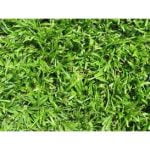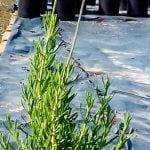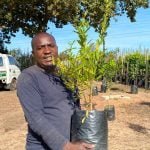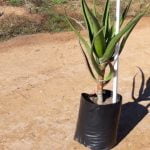Showing 109–120 of 124 resultsSorted by latest
-
Sale!

Hypoestes Aristata White 15cm Pot (ribbon bush)
Original price was: R95.00.R49.99Current price is: R49.99.Add to cartHypoestes Aristata White 15cm Pot
Common Name: Ribbon BushFull Sun
Semi Shade
Evergreen
Indigenous
Low Watering
Drought Resistant -
Sale!

Berea Grass (LM) Plug Tray
Original price was: R350.00.R279.99Current price is: R279.99.Add to cartBerea Grass (LM) Plug Tray
128 plug tray with Berea Grass plugs.
1 tray will cover approx 4sqm.Berea is a very soft bladed lawn grass that exhibits an incredibly high tolerance to shade, it is can be grown in both sun and shade.
It has a similar root structure to buffalo grass.
Please remember to set your grass mowers to the maximum height when cutting grass that grows in high shade areas, the grass needs a larger blade surface to help photosynthesize in low light areas.
Berea is tolerant of medium levels of traffic.
It has a lighter grass shade colour than buffalo grass.
-
Sale!

Halleria Lucida 17cm Pot
All Plants, All Plants On our Spring Sale, Full Sun Plants, Hedging Plants, Indigenous Plants, Semi Shade PlantsOriginal price was: R125.00.R89.99Current price is: R89.99.Add to cartHalleria Lucida 17cm Pot
Common names: Tree Fuchsia, White OliveFull Sun
Semi Shade
Evergreen
Wind Tolerant
Low Watering
IndigenousFast-growing, multi-stemmed tree that grows 3-4m in height with glossy foliage and nectar-laden, orange-red flowers in Autumn. Edible, black fruit attracts birds. Can be used as a screen and is ideal for small gardens!
Halleria lucida, commonly known as the tree fuchsia or notsung, is a small to medium-sized evergreen tree or shrub in the Stilbaceae family. It is native to Southern Africa, particularly in South Africa, Eswatini (Swaziland), and Mozambique. Here are the detailed aspects of Halleria lucida:
Botanical Characteristics
Leaves: The leaves are simple, lanceolate to ovate, and have a glossy, dark green appearance. They are alternately arranged and have a leathery texture.
Bark: The bark is greyish-brown and becomes rough and fissured with age.
Flowers: Halleria lucida produces striking tubular flowers that are orange to red, sometimes with a yellowish tinge. The flowers are often clustered along the branches and appear throughout the year, with a peak in spring and summer.
Fruit: The fruits are small, fleshy berries that turn dark purple or black when ripe. They are edible and attract birds and other wildlife.Growing Conditions
Climate: The tree fuchsia thrives in subtropical to temperate climates and is often found in forest margins, along streams, and in moist, shaded areas.
Soil: It prefers well-drained, fertile soils rich in organic matter. It can grow in various soil types but does best in loamy or sandy soils.
Watering: Halleria lucida benefits from regular watering, especially during dry periods, but is also somewhat drought-tolerant once established.Ecological Role
Habitat: It plays an essential role in its native habitat, providing nectar for birds, especially sunbirds, and insects such as bees and butterflies. The berries are a food source for various bird species.
Pollination: The tubular flowers are adapted to pollination by birds and insects, making it an important species for local pollinators.Uses
Ornamental: Due to its attractive flowers and foliage, Halleria lucida is widely used as an ornamental plant in gardens and landscapes. It can be pruned to shape and is suitable for hedges or as a standalone specimen.
Traditional Medicine: The leaves, bark, and roots are used in traditional African medicine to treat ailments such as coughs, colds, skin conditions, and digestive issues.
Edible Fruit: The berries, although small, are edible and can be consumed fresh or used in traditional remedies.Halleria lucida is a versatile and ecologically valuable plant, offering benefits for wildlife, traditional medicine, and ornamental gardening. Its adaptability and attractive features make it a popular choice for sustainable landscaping and conservation efforts.
-
Sale!

Strelitzia Nicolai 10lt
Original price was: R395.00.R199.99Current price is: R199.99.Add to cartStrelitzia Nicolai 10lt
Common Name: Natal Wild Banana, Giant Bird Of Paradise, Wild Banana TreeFull Sun
Semi Shade
Water Wise
IndigenousStrelitzia nicolai, commonly known as the White Bird of Paradise or Giant Bird of Paradise, is a striking tropical plant native to South Africa. It is a member of the Strelitziaceae family and is closely related to the more commonly seen Strelitzia reginae, known as the Orange Bird of Paradise.
Appearance: Strelitzia nicolai is known for its large, banana-like leaves and impressive size. The leaves are paddle-shaped, leathery, and typically grow in a fan-like arrangement. They are deep green in colour and have prominent veins. The plant can reach heights of up to 20 feet (6 meters) or more, making it a majestic presence in gardens or landscapes.
Flowers: While Strelitzia nicolai produces flowers, they are less commonly seen than those of Strelitzia reginae. The flowers of Strelitzia nicolai are white and similar in structure to those of Strelitzia reginae, consisting of an outer sheath called the spathe and an inner structure called the spadix. The flowers emerge from a long, erect stalk that extends above the foliage.
Growth Habit: Strelitzia nicolai grows in a clumping habit, with multiple stems emerging from the base. It forms dense clusters of foliage, creating a dramatic and tropical appearance. The plant can spread moderately wide, so it requires ample space to grow and develop.
Lighting Requirements: Strelitzia nicolai thrives in full sun to partial shade. It prefers bright, indirect light and can tolerate some direct sunlight, especially in the morning or evening. In areas with intense afternoon sun, it is beneficial to provide some protection or shade during the hottest parts of the day.
Temperature and Hardiness: Strelitzia nicolai is a tropical plant and is typically grown in warm climates. It is more cold-sensitive compared to Strelitzia reginae and prefers temperatures above 10°C. In colder regions, it is often grown as a houseplant or in containers that can be moved indoors during the winter.
Watering: Provide regular watering to keep the soil consistently moist but not waterlogged. Allow the top inch (2.5 cm) of soil to dry out slightly between waterings. During the winter months, reduce watering frequency as the plant enters a period of slower growth.
Soil and Fertiliser: Strelitzia nicolai prefers well-draining soil that retains some moisture. A mixture of loam, peat moss, and sand or perlite can provide suitable conditions. Fertilise the plant during the growing season (spring and summer) with a balanced, slow-release fertiliser or a liquid fertiliser diluted according to the package instructions.
Pruning and Maintenance: Prune Strelitzia nicolai to remove any dead or damaged leaves and to control its size and shape. Remove spent flowers to maintain tidiness. Regularly dust or wipe the leaves to keep them clean and promote healthy growth.
-
Sale!

Viburnum Sinensis 20lt
Original price was: R650.00.R359.99Current price is: R359.99.Add to cartViburnum Sinensis 20lt
Common Name: Sweet ViburnumFull Sun
Semi Shade
Low Watering
Wind tolerant
Excellent Hedging plantViburnum sinensis, commonly known as Sweet Viburnum, is a deciduous shrub found in South Africa. It belongs to the Adoxaceae family and is a favoured ornamental plant due to its beautiful flowers and attractive foliage.
Sweet Viburnum is renowned for its large, striking flower clusters that resemble fluffy, round snowballs, earning it its common name. These flower clusters can reach sizes of 15 to 20cm in diameter and are typically creamy white in colour. They grace the garden with their presence in late spring to early summer, creating a stunning visual display.
The leaves of Viburnum sinensis are oval-shaped, glossy, and dark green. During autumn, they often transition to hues of red or purple, adding to the shrub’s visual appeal. This particular shrub can grow to heights of 6 meters and has a rounded or slightly spreading growth habit.
Viburnum Sinensis thrives in areas with full sun to partial shade in South Africa. It prefers well-draining soil and exhibits tolerance to various soil types, including clay, loam, or sandy soil. Regular watering is necessary during the establishment phase, but once established, it can withstand some drought conditions.
Pruning is typically carried out after the flowering period to maintain the desired shape and remove any dead or damaged branches. This practice can also encourage better flower production for the following year.
Viburnum sinensis is generally a hardy and low-maintenance shrub in South Africa. It exhibits relative resistance to pests and diseases. However, it is recommended to monitor the plant for any signs of issues and take appropriate action if necessary.
Sweet Viburnum is often utilised as a focal point in landscaping, as a hedge, or as part of mixed shrub borders in South Africa. Its large, eye-catching flowers make it a standout in the garden and attract bees and butterflies. Additionally, the flowers can be cut and used in floral arrangements to bring their beauty indoors.
Overall, Viburnum sinensis, is a delightful shrub appreciated for its stunning flower clusters and attractive foliage in South African gardens. Its resilience, low maintenance requirements, and versatility in various garden settings make it a popular choice for adding beauty and charm to outdoor spaces.
-
Sale!

French Lavender Purple 4lt
All Plants, All Plants On our Spring Sale, Full Sun Plants, Hedging Plants, Indigenous Plants, Semi Shade Plants, Water Wise PlantsOriginal price was: R85.00.R54.99Current price is: R54.99.Add to cartLavandula Dentata Purple 4lt
Common Name: French LavenderFull Sun
Low watering
Wind tolerant
EvergreenShrub growing up to 1.5m in height with blue-purple scented flowers in Spring and Summer.
Nice for a low laying hedge! -
Sale!

Pomegranate Wonderful Tree 10lt
Original price was: R350.00.R239.99Current price is: R239.99.Add to cartPomegranate Tree 10lt
Full Sun
Moderate Watering
Wind Tolerant
Drought Tolerant Once Established
Fruiting TreeThe “Wonderful” pomegranate is a specific cultivar (cultivated variety) of pomegranate (Punica granatum). It is one of the most well-known and widely grown pomegranate varieties, highly regarded for its large, sweet, and flavourful fruits. Here are some key characteristics and information about the “Wonderful” pomegranate:
Fruit
The Wonderful pomegranate is prized for its large and strikingly deep red or dark crimson fruit. The skin of the fruit is thick and leathery, and the arils (the juicy, seed-covered pulp) inside are known for their sweet and tangy flavour.Taste
The arils of the are particularly sweet with a pleasant tartness, making them suitable for fresh consumption or juicing. The balance of sweetness and tartness in the arils is often preferred for culinary uses.Size
The fruit of the are typically larger than that of many other pomegranate varieties, with some specimens reaching the size of a grapefruit.Ripening
These pomegranates typically ripen in the fall, usually from September to November, depending on the region and climate. Ripe fruits have a deep, vibrant colour, and they make a metallic sound when tapped.Growing Conditions
Like most pomegranate varieties, these thrive in regions with hot, dry summers. They require full sun and well-drained soil. The tree is known for its drought tolerance, making it a good choice for arid and semi-arid climates.Cultivation
They can be grown from seeds, but it is more commonly propagated through cuttings or by grafting onto rootstock. This ensures that the tree retains the characteristics of the parent plant, such as the desirable fruit characteristics.Versatility
The Wonderful pomegranate is suitable for a variety of uses, including fresh eating, making juice, and incorporating into a range of culinary dishes, from salads to desserts.Health Benefits
Like all pomegranates, wonderful pomegranates are a good source of antioxidants and various vitamins and minerals. Consuming the arils or juice is associated with potential health benefits, such as supporting heart health and reducing inflammation. -
Sale!

Viburnum Tinus Lucidum 10lt
Original price was: R350.00.R199.99Current price is: R199.99.Add to cartViburnum Tinus Lucidum 10lt
Full Sun
Wind Tolerant
Low Watering
EvergreenDark green, shiny-leaved shrub growing up to 4m in height with delicate, white flowers in Spring and Summer. Can form a nice hedge!
-
Sale!

Tree Aloe 20lt (Aloidendron Barberae)
Original price was: R650.00.R449.99Current price is: R449.99.Add to cartAloidendron Barberae 20lt
Common Name: Tree Aloe, Boomaalwyn, MikaalwynFull Sun
Semi Shade
Water wise
Indigenous
Wind Tolerant
Drought Tolerant -
Sale!

Viburnum Sinensis 10lt
Original price was: R350.00.R199.99Current price is: R199.99.Add to cartViburnum Sinensis 10lt
Common name: Sweet ViburnumFull Sun
Semi Shade
Low Watering
Wind tolerant
Excellent Hedging plantFull Sun
Semi Shade
Low Watering
Wind tolerant
Excellent Hedging plantViburnum sinensis, commonly known as Sweet Viburnum, is a deciduous shrub found in South Africa. It belongs to the Adoxaceae family and is a favoured ornamental plant due to its beautiful flowers and attractive foliage.
Sweet Viburnum is renowned for its large, striking flower clusters that resemble fluffy, round snowballs, earning it its common name. These flower clusters can reach sizes of 15 to 20cm in diameter and are typically creamy white in colour. They grace the garden with their presence in late spring to early summer, creating a stunning visual display.
The leaves of Viburnum sinensis are oval-shaped, glossy, and dark green. During autumn, they often transition to hues of red or purple, adding to the shrub’s visual appeal. This particular shrub can grow to heights of 6 meters and has a rounded or slightly spreading growth habit.
Viburnum Sinensis thrives in areas with full sun to partial shade in South Africa. It prefers well-draining soil and exhibits tolerance to various soil types, including clay, loam, or sandy soil. Regular watering is necessary during the establishment phase, but once established, it can withstand some drought conditions.
Pruning is typically carried out after the flowering period to maintain the desired shape and remove any dead or damaged branches. This practice can also encourage better flower production for the following year.
Viburnum sinensis is generally a hardy and low-maintenance shrub in South Africa. It exhibits relative resistance to pests and diseases. However, it is recommended to monitor the plant for any signs of issues and take appropriate action if necessary.
Sweet Viburnum is often utilised as a focal point in landscaping, as a hedge, or as part of mixed shrub borders in South Africa. Its large, eye-catching flowers make it a standout in the garden and attract bees and butterflies. Additionally, the flowers can be cut and used in floral arrangements to bring their beauty indoors.
Overall, Viburnum sinensis, is a delightful shrub appreciated for its stunning flower clusters and attractive foliage in South African gardens. Its resilience, low maintenance requirements, and versatility in various garden settings make it a popular choice for adding beauty and charm to outdoor spaces.
-
Sale!

Aristida Junciformis Grass 4lt
All Plants, All Plants On our Spring Sale, Full Sun Plants, Indigenous Plants, Lawn and Grasses, Semi Shade PlantsOriginal price was: R99.99.R54.99Current price is: R54.99.Add to cartAristida Junciformis Grass 4lt
Common names: Bristle Grass, Gongoni Grass,Full Sun
Low to Medium Watering
Wind Tolerant
Evergreen
IndigenousFast-growing, drought resistant hardy grass. Grows to heights of 50-75cm. Will grow in wet places and flowers from Summer to Autumn.
-
Sale!

Viburnum Sinensis 17cm Pot
Original price was: R125.00.R89.99Current price is: R89.99.Add to cartViburnum Sinensis 17cm Pot
Common Names: Sweet Viburnum,Full Sun
Semi Shade
Low Watering
Wind tolerant
Excellent Hedging plantFull Sun
Semi Shade
Low Watering
Wind tolerant
Excellent Hedging plantViburnum sinensis, commonly known as Sweet Viburnum, is a deciduous shrub found in South Africa. It belongs to the Adoxaceae family and is a favoured ornamental plant due to its beautiful flowers and attractive foliage.
Sweet Viburnum is renowned for its large, striking flower clusters that resemble fluffy, round snowballs, earning it its common name. These flower clusters can reach sizes of 15 to 20cm in diameter and are typically creamy white in colour. They grace the garden with their presence in late spring to early summer, creating a stunning visual display.
The leaves of Viburnum sinensis are oval-shaped, glossy, and dark green. During autumn, they often transition to hues of red or purple, adding to the shrub’s visual appeal. This particular shrub can grow to heights of 6 meters and has a rounded or slightly spreading growth habit.
Viburnum Sinensis thrives in areas with full sun to partial shade in South Africa. It prefers well-draining soil and exhibits tolerance to various soil types, including clay, loam, or sandy soil. Regular watering is necessary during the establishment phase, but once established, it can withstand some drought conditions.
Pruning is typically carried out after the flowering period to maintain the desired shape and remove any dead or damaged branches. This practice can also encourage better flower production for the following year.
Viburnum sinensis is generally a hardy and low-maintenance shrub in South Africa. It exhibits relative resistance to pests and diseases. However, it is recommended to monitor the plant for any signs of issues and take appropriate action if necessary.
Sweet Viburnum is often utilised as a focal point in landscaping, as a hedge, or as part of mixed shrub borders in South Africa. Its large, eye-catching flowers make it a standout in the garden and attract bees and butterflies. Additionally, the flowers can be cut and used in floral arrangements to bring their beauty indoors.
Overall, Viburnum sinensis, is a delightful shrub appreciated for its stunning flower clusters and attractive foliage in South African gardens. Its resilience, low maintenance requirements, and versatility in various garden settings make it a popular choice for adding beauty and charm to outdoor spaces.
